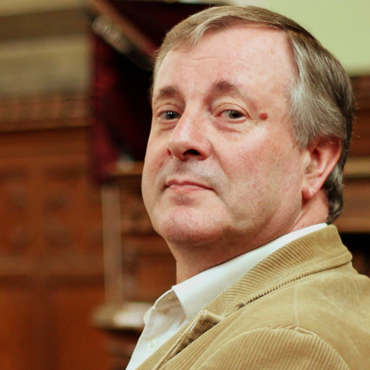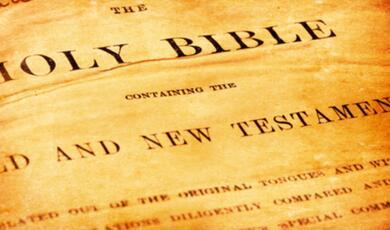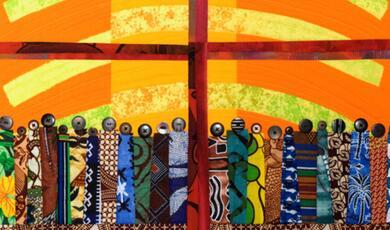Is Matter Evil?
Share
- Details
- Text
- Audio
- Downloads
- Extra Reading
One of the great theological debates in the early church arose from Gnosticism, a movement in late antiquity which held that the material world was evil. Salvation was understood in terms of deliverance from the material world into a spiritual realm. Early Christian writers resisted the idea, holding that the material world was not evil. Yet many questions remain unresolved, particularly the question of how human beings are able to transcend the material order.
This lecture explores such questions in dialogue with Philip Pullman's complex Dark Materials trilogy which provides a framework for discussing how human beings relate to the material world, and the origin of evil.
Download Text
9 May 2017
Is Matter Evil?
Philip Pullman’s Dark Materials Trilogy
Professor Alister McGrath
Welcome to this final of my six Gresham Lectures in Divinity this year. As you will recall, my hope had been to use this lecture course to open up six interesting and important questions with an obvious religious or theological dimension, which also have a much wider cultural and scientific relevance. In each case, I tried to choose some interesting person to interact with, so that you would get to hear other perspectives and voices, rather than being limited to just mine. Of course, I have always been very happy to tell you what I think, but my aspiration in these lectures is to help you think things through, and make up your own mind about these ideas, rather than impose my ideas upon you.
In this final lecture, I turn to deal with a question that often hovers around many discussions of the place of humanity in the world, and especially the question of what makes us distinct as human beings. We live in a universe that is made out of what we loosely call “matter”. Our bodies are made up of this same matter. Yet while most human beings think of themselves as transcending matter, the question of how we fit into a material universe remains important and open. Some philosophers, for example, argue that the human mind has a non-material, spiritual dimension that certainly includes consciousness and might include more. Some religious writers argue that humanity consists of a material body and an eternal spiritual soul.
Some of you may know of the famous – we might even say infamous – experiment carried out in 1907 by Dr Duncan MacDougall in Massachusetts. MacDougall weighed patients who were dying of tuberculosis, and reported a strange and sudden weight loss at the moment of death in four cases. MacDougall concluded that what he called the “departure of the soul from the body” could be observed. Even more than that, he argued that he had discovered how much the soul weighed – something between “one-half to a full ounce”. MacDougal’s experiment received a lot of attention, including a somewhat uncritical report in the New York Times. Some media reports even converted this figure to the metric system, and reported that the soul weighed “21 grams”.
Nowadays. this experiment is now regarded as hopelessly flawed, and the idea of the soul weighing about an ounce is widely ridiculed, even though it makes an appearance in Dan Brown novel’s novel The Lost Symbol. But that is not the point. MacDougall’s experiment is a telling indicator of the continuing influence of the idea of an immortal soul, trapped within the human body, and only able to escape at death. It’s not a specifically religious idea, let alone a Christian idea. It actually originated within classical Greek philosophy, at least five hundred years before Christianity appeared on the scene. Yet the idea that human beings are material objects inhabited by a spiritual soul is still deeply influential in western culture.
Modern neuroscience has no place for the idea of a “soul”, understood as some immaterial part of the body. Neither does the Christian Bible. The “soul-body” dualism lives on in popular culture, both secular and Christian. Yet the best view – found in both contemporary neuroscience and Christian theology – is to think of humanity as a physical unity – a single body, not a “body and soul”. This may surprise some of you, so let me say a little more about this. The word “soul” is an Anglo-Saxon term that is used to translate a variety of biblical terms, which often have the general sense of “life”. Thus the Hebrew word nephesh, which is translated as “soul” in some older English Bibles, really means a “living being.” The Old Testament conceives of humanity “as an animated body and not as an incarnate soul”.[1]
The leading New Testament scholar James Dunn points out that St Paul adopts what he calls an “aspective,” not a “partitive,” understanding of terms such as “soul”, “flesh” and “body”. “Paul’s conception of the human person is of a being who functions within several dimensions.”[2] To “live according to the flesh” does not mean being directed by some specific part of the body, but to live at a purely human level, disregarding the spiritual side of life. Yes, we are made up of matter – but we are able to live in certain ways that transcend out material origins.
One of the reasons why science is so successful is its use of “reductive explanation”, by which complex systems are reduced to more manageable simpler mechanisms – such as atoms and molecules. Yet there are serious questions about whether this reductive approach is helpful in making sense of human nature. Let’s look at this quotation from the biologist Francis Crick:[3]
“You,” your joys and your sorrows, your memories and your ambitions, your sense of personal identity and free will, are in fact no more than the behaviour of a vast assembly of nerve cells and their associated molecules. . . . You’re nothing but a pack of neurons.
Crick’s highly reductive approach to human identity seems to assume that a complicated system is no more than the sum of its parts – and that one of these components can be singled out as being of defining importance. The most generous way of understanding Crick’s hopeless overstatement is to suggest that it is a neurologist’s perspective on human nature, which somehow manages to ignore the obvious fact that there is a lot more to human nature than neurons. Of course we need these if we are to function properly. But we are not defined exclusively, or characteristically, in this way. There is more that needs to be said.
Now many of those who protest against such reductionist accounts of human beings are religious. Yet we need to note that many of those who protest against this trend are atheist scientists who are deeply concerned about the inadequacy of this kind of approach. Raymond Tallis is a good example of a leading atheist who regards such views as indefensible and dehumanizing.[4]
“I am an atheist humanist; but this does not oblige me to deny what is staring me in the face – namely, that we are different from other animals, and that we are not just pieces of matter.”
The first problem with such a reductionist approach is this. Human beings are enormously complex, and are best understood as having many levels – physical, chemical, biological, psychological, sociological, and so on. Each of these levels is important; none of them on their own is adequate as a description of who we are. To appreciate the full significance of humanity, we need to consider all of these, not declare that only one of them really defines us. In any case, if there is indeed something distinctive about human nature, it lies in the upper levels of consciousness, not the lower levels of physical and chemical composition.
The second problem is more subtle. Science rightly uses reductionist approaches as one of several tools to study a system. If you break a system down into its individual parts, you will end up understanding the behaviour of the whole system better. But when the individual components of a system come together, new properties emerge at the level of the system as a whole which were not present in any of its components beforehand. This phenomenon, usually referred to as “emergence”, is now seen as serious problem for simplistic forms of reductionism. Within a system, properties emerge at higher levels that were not present at lower levels. More importantly, these properties could not be predicted solely on the basis of a knowledge of the lower levels of the system. So knowing that human beings are made up of atoms and molecules tells us nothing about the remarkable capacities of human beings which emerge at the levels of thought and consciousness.
Reductive views of humanity often represent a single aspect of human existence as if it were the totality of that existence – or at least the aspect that really matters. Yet this view surely needs to be challenged. For a start, it overlooks the relational and social aspects of human life, which are difficult to reduce to materialist categories. Human beings need to exist in relationships. As Aristotle pointed out more than two thousand years ago, human beings are social animals. It’s a vitally important aspect of human existence. Yet it is only part of a more complex picture, not something which can be isolated from the remainder of human life, and treated as if it were the essence of human nature. The best way of challenging these inadequate and partial approaches is to set out a richer and deeper vision of human nature which includes what is good about them. Human beings are complex systems; our whole transcends our individual parts. Yes, we are part of the material order, but that does not mean that we can be reduced to the level of the material order. That can be done, and indeed has been done – and it is called “dehumanization”.
So how do we relate to the material world? Let me focus on one very well-known way of thinking about this. There is a material world, which is evil. And there is a spiritual world, which is good. Human beings are spiritual creatures, and must therefore avoid being contaminated by the material world, which constantly threatens to subvert or destroy our distinct identity as human beings.
Now many of you will recognize this dualist way of thinking. So where does it come from? And where does it take us? Some might suggest that it’s a Christian way of thinking. Yet it’s not. Mainline Christianity has consistently held that matter is not intrinsically evil; it is God’s good creation, which has fallen, and is susceptible to restoration and renewal. For Irenaeus of Lyons, widely regarded as one of the most important theologians of the second century, the doctrine of the incarnation and the Christian use of sacraments represent explicit denials of any Gnostic notion of an intrinsically evil matter. Did not God choose to become incarnate, uniting himself to human nature? Does not the church use material elements – such as water, wine and bread – as symbols of divine grace and presence?
Now let me make it clear that this kind of dualism is certainly encountered on the fringes of Christianity – for example, in the medieval movement known as the “Cathars”, which flourished in some parts of northern Italy and southern France between the 12th and 14th centuries. But it is not the mainline position. So where does this dualism come from?
The answer lies mainly in the movement known as “Gnosticism” (a term derived from the Greek word gnōsis, “knowledge”). We need to use this term cautiously, as there are very good reasons for thinking that it was not a coherent and well-defined movement, with a well-formed set of beliefs. There is a growing consensus within the academy that the term “Gnosticism” is misleading, in that it gathers together a number of quite disparate groups, and presents them as if they represented a single religious belief system.[5] So do we need to give up on using the words “Gnosticism” and “Gnostic”? No. They simply need to be used with caution to refer to a family of religious doctrines and myths that flourished in late classical antiquity which maintain or presuppose that the cosmos is a result of the activity of an evil or ignorant creator, and that salvation is a process in the course of which believers receive the knowledge of their divine origin, so that they are enabled to return to the realm of light after having been freed from the limitations of the physical world in general, and the human body in particular.
In general, Gnosticism held that the demiurge created the physical world without any knowledge of the “true God”, falsely believing that he was the only God. This idea of an inferior creator god, the demiurge, is found in classical Greek philosophy, and plays a significant role in Plato’s dialogue Timaeus. Since the demiurge acted in ignorance of – or perhaps even as an act of rebellion against – the true God, his creation had to be considered as at best imperfect, and more probably evil.
So what of the place of humanity within this created order? While the human body was created by the demiurge, it nevertheless contains a divine spirit which enabled it to establish a connection with the highest God. For this reason, human beings may be regarded as being superior to their creator. The divine “spark” within humanity possesses a homing instinct, longing to break free of the body and achieve its true destiny. The aim of the body created by the demiurge is to function as a prison, and cause humanity to repress or forget the divine spirit within. The Greek slogan sōma sēma (“the body is a prison”) expresses this notion well. Yet this spark can be awoken if and when a divine messenger awakes individuals from their dream of forgetfulness, thus allowing it to illuminate humanity through this esoteric knowledge, and reconnect with its divine origins.
Valentinism, a form of Gnosticism which presented itself as a form of Christianity, held that Jesus Christ is to be seen as a redeemer-figure, who awakens the divine spark within humanity, thus enabling us to find its way back to its true home. In order to save those who were held captive by the body, the Saviour “let himself be conceived and he let himself be born as an infant with body and soul”. Theodotus, another Gnostic who aimed to emphasise the continuity between Christianity and Gnosticism, taught that the savior, or Logos, descended from the spiritual realm to the physical world, where he assumed a “spiritual flesh” in order to allow the spiritual elements trapped in earthly human beings to be reunited with their divine origins.
For Gnosticism, humanity had fallen into an evil and corrupt world by mistake. We are gold in the mud. We belong somewhere else. The only way of preserving our human goodness and identity is by escaping from this corrupt world, and finding our way back to our true homeland. And that is where the idea of gnosis comes in.
Some of you will have been wondering why this movement was called Gnosticism, when it seemed to have little about it that is linked with knowledge, as we now understand this term. Well, the answer is that the “knowledge” in question is esoteric knowledge – the secret knowledge, known only to the initiated, of the manner in which you can escape from this world. In some forms of Gnosticism, this was understood as a knowledge of the cosmic passwords which would allow the initiated and enlightened to pass through hidden doorways into the spiritual realm where they really belong.
Gnosticism was highly influential in its time, and has re-emerged in various forms. One of its central themes is whether matter, which was created by either an incompetent or evil God, has the potential to imprison or contaminate an essentially spiritual humanity. If this is so, then the solution lies in trying to extricate ourselves from our physical environment. What is interesting is how Gnosticism used a vocabulary which was in many ways similar to that of Christianity – for example, speaking of salvation and a saviour – while interpreting these in ways very different from those associated with Christianity. Yet there are some affinities here with Christianity, especially the recognition of some instinct that this world is not where we really belong. Here’s this idea as we find it in G. K. Chesterton: “We have come to the wrong star ... That is what makes life at once so splendid and so strange. The true happiness is that we don’t fit. We come from somewhere else. We have lost our way.”[6]
So what does Pullman mean by dust? And what is its significance? Scholarly studies of Pullman’s use of the category of “dust” have emphasised its ambiguity. It is open to multiple interpretations, serving as an “all-Inclusive, multifunctional metaphor.” The concept seems to undergo shifts in meaning from one volume to another in the trilogy, leading one scholar to suggest that “its indistinctness lies in its intrinsic amorphousness.”[7] So how does Pullman explore this metaphor, and how does he understand it to illuminate human existence?
In the first volume in the trilogy, published in the United Kingdom as Northern Lights and in North America as The Golden Compass, dust is initially described as “a new kind of elementary particle.”[8] It is unclear how this illuminates its distinct character, as what we think of scientifically as “elementary particles” are not generally considered to have moral or spiritual implications. Yet perhaps its significance is captured a little more expansively in the suggestion that it might function as some kind of metaphor for “original sin”, which leads the central character Lyra to think of it in terms of “dark intentions, like the forms of thoughts not yet born”.[9]
A much more interesting thought, which is brought out most clearly in The Amber Spyglass, the third volume of the trilogy, is that Dust is self-conscious matter, with a capacity for catalysing the emergence of consciousness. Dust is a catalyst of human development, in which we leave behind a state of innocence, and move into the realm of experience and maturity. Pullman portrays the Magisterium – which I take to be a caricature of the Catholic church – as wanting to petrify a child’s development is a pre-sexual phase. “To the Church then, Dust symbolises the awakening of sexual awareness, humanity’s rejection of the heavenly for the earthly, and thus, a descent from spirit to matter.”[10] Pullman offers a criticism of notions of sin that he sees as being bound up with human physicality.
This is an important point, and I will be coming back to it. Pullman’s magisterium clearly seems Gnostic rather than Christian to me (for example, I think of his suggestion that the Church sees both the human body and the world which it inhabits as “material and sinful”),[11] but there is a genuine issue here. One of the best discussions of this is found in the fifth century Christian writer Augustine of Hippo, who rejected Manicheanism – which we would now see as some form of Gnosticism – in order to embrace Christianity. For Augustine, one of the key questions was how to affirm the utility and wonder of sexual attraction, without allowing it to overwhelm us and thus become the cause of our own dehumanization, or on the part of those who we feel attracted to, who can so easily be treated as objects of sexual gratification. Like many, I am disturbed by what I see as the cultural manipulation of sexual awareness in our own day.
For Pullman, dust is creative – something which injects intellectual energy into mere matter. He thus holds that dust both initiates a child’s development toward adulthood, while also serving as an underlying energy vital to human existence in general, without which it would all vanish. “Thought, imagination, feeling, would all wither and blow away, leaving nothing but a brute automatism.”[12] It is clear that Pullman does not see Dust as entailing any kind of reductionist materialism, which reduces human beings to the biological realm, but rather than it catalyses the emergence of those higher functions which we regard as being characteristic of flourishing human beings. Once more, I agree with him. Accepting that we are made of “dust” does not mean that we are reduced to the level of dust – in other words, that we are the prisoners of physical forces, and are incapable of rising above the physical level. The domains of thought, imagination, and feeling seem to me to be right at the core of human distinctiveness.
As I read Pullman, I find myself being intrigued and stimulated by his ideas, even if his criticisms of a fictional magisterium seem at times rather overstated. As I have noted, Pullman uses the term “dust” in a very broad and wide-ranging fashion, almost as a metaphor for the fundamental unity of the universe, which ought to elicit a corresponding unity on the part of its human observers and interpreters. Yet one of the most fascinating themes in the Dark Materials trilogy is Pullman’s own creation myth, which he proposes as an alternative to others – such as that of Christianity. Pullman sets this out especially clearly in a 2004 conversation with Rowan Williams:[13]
Modern psychology points to there being a universal human sense of a need for meaning.[14] Not everyone shares this experience, and not everyone who experiences this need goes on to reflect on its implications. But for most people, it’s there, and it’s important. Meaning in life could be defined psychologically as:[15]
“the extent to which people comprehend, make sense of, or see significance in their lives, accompanied by the degree to which they perceives themselves to have a purpose, mission, or overarching aim in life”.
This often takes the form of a longing to for a sense of personal coherence. We want to understand our experience and to feel that our lives have significance and purpose. Psychology cannot tell us what life means; after all, that’s not an empirical question. It does, however, make it clear how enormously important this notion is for human beings, and the difference that it makes to human flourishing and wellbeing.
We may not understand why, but it is natural for us to believe there is some meaning to be found, and to try and find it. At one level, we are looking for a “global” way of thinking – a “big picture” which interprets and illuminates our world and our experience. Yet this “big picture” needs to be applied locally – to situations that we need to understand, to problems that we need to solve, and to challenges we need to face. This “situational” aspect of meaning is best seen in the realm of attitudes, values, and behaviour, where our beliefs about the nature of things find their expression in what we actually do.
Although some “big picture” philosophical systems such as Marxism do indeed engage these questions, it is widely agreed that religion is one of the most common and powerful sources of meaning. Religion can provide individuals with a comprehensive and integrated framework of meaning that helps to explain many worldly events, experiences, and situations in ways that satisfy both cognitive and existential concerns, while providing a way of helping them to transcend their own concerns or experience and connect with something greater.
While religion has many aspects, one of its most important is its capacity to provide a comprehensive framework of interpretation of experience and life that allows the discernment of meaning. The philosopher Keith Yandell offers a good account of this aspect of religion:[16]
“A religion is a conceptual system that provides an interpretation of the world and the place of human beings in it, bases an account of how life should be lived given that interpretation, and expresses this interpretation and lifestyle in a set of rituals, institutions and practices”.
Religion is able to embrace and inform a vast scope of issues, including beliefs about the world (such as human nature, our social and natural environment, and the afterlife), contingencies and expectations (rewards for acting well and punishment for doing evil), goals (such as benevolence and altruism), actions and attitudes (such as compassion, charity, and violence) and emotions (such as love, joy, and peace).[17] They provide a sense of significance, particularly in enabling individuals to feel part of a greater scheme of things. The term “big picture” is particularly helpful in conveying this idea of a perception of coherence within a complex world of experience, and helping individuals to relate their own situation to a greater reality. We need more than what science can provide us if we are to lead meaningful lives. The philosopher Ludwig Wittgenstein was clear on this point. “We feel that even if all possible scientific questions be answered, the problems of life have still not been touched at all.”[18] Science can only offer limited guidance as we reflect on the issues of meaning and value.
Albert Einstein explored this point in a landmark lecture at Princeton Theological Seminary in 1939.[19] Einstein insisted that the natural sciences were outstanding in their sphere of competence. Yet he cautioned that “the scientific method can teach us nothing else beyond how facts are related to, and conditioned by, each other.” Human beings need more than what a “purely rational conception of our existence” is able to offer.
Yet opening up such fundamental questions of meaning and value does not cause us to lapse into some kind of superstitious irrationality. “Objective knowledge provides us with powerful instruments for the achievements of certain ends, but the ultimate goal itself and the longing to reach it must come from another source.” For Einstein, the fundamental beliefs which are “necessary and determinant for our conduct and judgments” cannot be developed or sustained in a “solid scientific way.” Einstein was emphatic that this was not a criticism of science. It was simply an informed and necessary recognition of their limits. Science and religion together, in their different ways, offer angles of approach to the great questions of life.
But it is time for me to wrap up, not only this individual lecture, but this entire lecture series. My main concern has been how we engage with this complex world in which we live, whether by looking at ourselves, the night sky, or the beauties of a mountain landscape. I have suggested that we need what we might call a “stereoscopic vision”, which involves both those cultural enterprises that we loosely call “science” and “religion”. I imagine that each of us will have our own way of thinking about these two very different approaches to our world and to ourselves. Yet my argument is that we end up weaving both into our narratives of life. In these lectures, I have explored multiple issues and approaches, and hope that my reflections, and those of my dialogue partners, will be helpful to you as you think further about these issues. We may not have resolved these questions, but at least we have opened them up for further consideration.
©Professor Alister McGrath, 2017
[2] James D. G. Dunn, The Theology of Paul the Apostle. Grand Rapids, MI: Eerdmans, 1998, 51-78.
[6] G. K. Chesterton, Tremendous Trifles. London: Methuen, 1909, 209.
[8] Philip Pullman, Northern Lights. London: Scholastic, 1995, 370.
[9] Pullman, Northern Lights, 371; 390.
[10] Bird, “Without Contraries Is No Progression”, 116.
[11] Pullman, Northern Lights, 32.
[12] Philip Pullman, The Amber Spyglass. London: Scholastic, 2000, 476.
[13] http://www.telegraph.co.uk/culture/3613962/The-Dark-Materials-debate-life-God-the-universe....html
[18] Ludwig Wittgenstein, Tractatus Logico-Philosophicus, 6.52.
[19] Albert Einstein, Ideas and Opinions. New York: Crown Publishers, 1954, 41-9.
This event was on Tue, 09 May 2017
Support Gresham
Gresham College has offered an outstanding education to the public free of charge for over 400 years. Today, Gresham College plays an important role in fostering a love of learning and a greater understanding of ourselves and the world around us. Your donation will help to widen our reach and to broaden our audience, allowing more people to benefit from a high-quality education from some of the brightest minds.


 Login
Login







